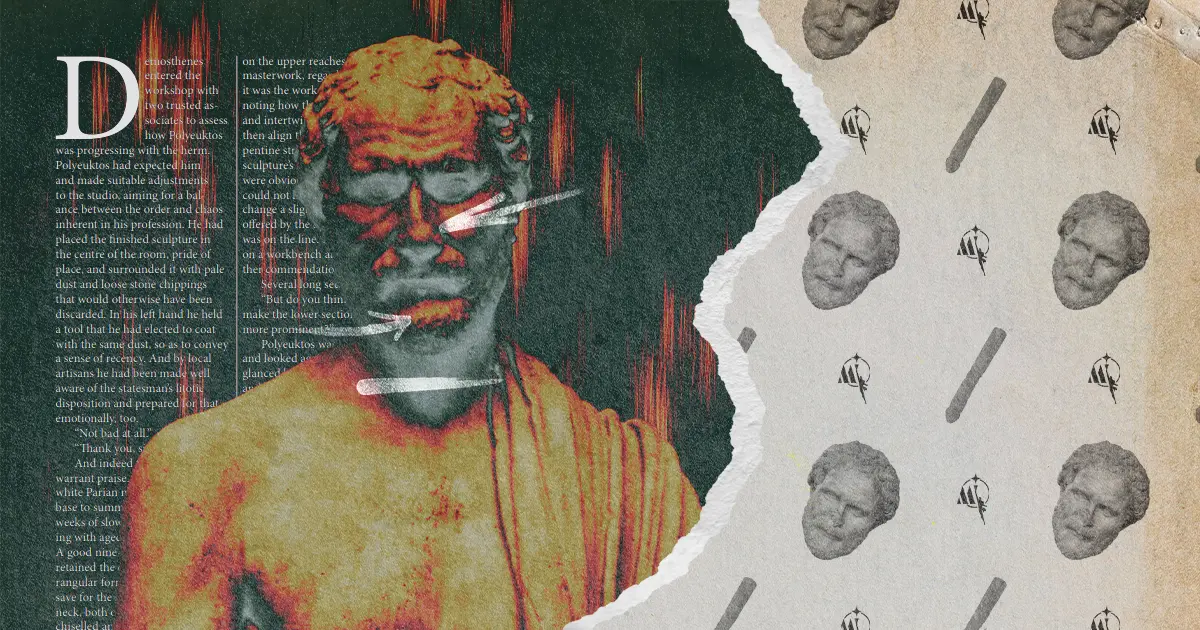The Sculpture of Demosthenes
Demosthenes entered the workshop with two trusted associates to assess how Polyeuktos was progressing with the herm. Polyeuktos had expected him and made suitable adjustments to the studio, aiming for a balance between the order and chaos inherent in his profession. He had placed the finished sculpture in the centre of the room, pride of place, and surrounded it with pale dust and loose stone chippings that would otherwise have been discarded. In his left hand he held a tool that he had elected to coat with the same dust, so as to convey a sense of recency. And by local artisans he had been made well aware of the statesman’s litotic disposition and prepared for that, emotionally, too.
“Not bad at all.”
“Thank you, sir.”
And indeed the work did warrant praise. All fine-grained white Parian marble, six feet from base to summit, the result of three weeks of slow and fastidious carving with aged, enduring hands. A good nine-tenths of the piece retained the original stark quadrangular form of the block itself, save for the statesman’s head and neck, both of which were assuredly chiselled and led to a slanting arch of shoulder and chest that would announce the top of the sculpture, and – as was customary – the subject’s genitalia islanded in the centre of the block, not ithyphallic as with many showier pieces but restrained and indifferent, seemingly conforming to the low temperatures of the workshop. He had done well to capture Demosthenes’ likeness, the renowned dark caustic gaze framed by an otherwise neutral countenance. And Polyeuktos found himself admiring the finer details of the hair on the upper reaches of this latest masterwork, regarding it now as if it was the work of another sculptor, noting how the follicles weaved and intertwined obliquely only to then align themselves with the serpentine stretches of the beard. The sculpture’s apotropaic properties were obvious to all, and Polyeuktos could not help but smile and exchange a slight bow for the acclaim offered by the statesman. Much was on the line. He placed the tool on a workbench and awaited further commendation.
Several long seconds passed.
“But do you think you could make the lower section a little more prominent?”
Polyeuktos was perplexed and looked again at the sculpture, glanced back at the statesman, and then awkwardly cambered around the room in an effort to see the aforementioned section with new eyes. Prominent? He walked back to face Demosthenes, whose assistants mirrored the seriousness of their employer.
“You’re not content with the size, sir?”
“No, no. The size is good. It’s most precise. Aesthetically, too, down to the very… each individual… well… in fact, actually, how did you–“
The assistants interrupted in unison, one angling his right hand to navel height and wagging his index finger, ostensibly to dissuade the statesman from advancing this line of questioning, and the other taking a reproachful step forward while contriving a cough into a clenched fist. Demosthenes paused for a moment and concurred.
“No. As I say, my issue is with the prominence. I enter the room and my eyes are first drawn to the head, then downward, and then back almost immediately to the head. And when I try to consider the whole piece my eyes are still drawn to the head.”
“Well… that’s natural, sir. It’s eye level, after all. And, if I may be so bold, it’s a most noble head. A true statesman’s expression. Proud, astute, honourable… very astute, and most proud, and–“
“And therein lies the problem.”
Polyeuktos compared the expression of the sculpture with that of its subject, as he had done so frequently in recent weeks. He could see no issue with either the accuracy of representation or the expression itself. It was a good representation, a good expression. He touched his own face, contorting it in imitation, creasing his forehead and downturning the corners of his mouth – his lips now protracted and thin, the upper concealed entirely – and ensuring no stray facial hair belied the fleeting nobility of this new facade. He had sculpted an excellent representation. Perhaps this was a test, some form of trial, a rite of passage. But why now, after so many decades? He worried that perhaps he had failed to understand the commission. Miscommunication? A flaw in Athenian bureaucracy? Or perhaps it was a joke. A cruel joke, no doubt, given the severity of the circumstances. Defeated, he turned to Demosthenes for additional comment.
“Remove your hands from your face, sculptor.” The tone was now more distant, more consciously hierarchical. “Eye level. That’s the problem, not the expression. I couldn’t give a damn about the expression. It’s the other part that’s the problem.”
“The… genitals, sir?”
Demosthenes winced. “There are women nearby, Polyeuktos. Watch your tongue.” Polyeuktos solemnly nodded and scanned the scene to witness a complete absence of women. There was a preliminary cast of Demeter in the corner, however, and he used that as inspiration to forge the appropriate reaction. He lowered his head. “Apologies, sir.”
“But yes. The genitals – as you so bluntly call them – need to be more prominent. How do we achieve that? More to the point, how do you achieve that? And how do you achieve that by the end of the week, say? Or by the end of tomorrow?”
The assistants were staring at the withering sculptor, flanking the statesman like birds in formation.
“I could…” He fumbled for ideas. Pressure was building. One’s livelihood depended on moments like this, though never exactly like this. “Invert the whole thing, I suppose. Turn it upside down, so the head was at the bottom end and the other section at eye level. And you can decide whether or not the head goes upright, to keep it better recognisable, or turn it… topside-downward too, in line with the new… new aesthetic of the new design, the sculpture, so it would be the other way. Around, you see.” Every sentence was bedrocked by uncertain stutterings and unorthodox collocations, and several disparate hand gestures amalgamated into one. And all of this in front of the famed orator. His wife and children must never know. And he was acutely aware that this wayward explanation may soon ruin them all.
“Or, sculptor…” – there was escalating hostility being packed into this word – “we could forego the head entirely, couldn’t we. Minimise distractions.”
“So just… the lower section, sir?”
“Two of them. One on top of the other. One higher, at eye level, and one lower. But each the same.”
Polyeuktos visualised such a thing. The traditional herm – and he had created over fifty in his lifetime, since his days as an apprentice – featured both the head and genitalia, perhaps with jewellery or headwear or other adornments accompanying the former, but always with a head and always with genitalia. The head made the sculpture recognisable, a symbol that should simultaneously lack emotion and convey central facets of character. The genitalia, placed in relation to the head as they would be on the skin-and-blood subject, represented the fertile masculinity of that individual, as one would expect. But here, with no head, there would be no individual whose fertility could be represented. A lone phallus. No, thought Polyeuktos, two lone phalli, lone in spirit due to their distance from one another, like twin brothers sundered at birth, but still very much a corporeal pair. Four testes, then, too. If you were to map the testes, Polyeuktos realised, you would see a parallelogram an inch or so in width but three and a half feet tall, separated by an unmarked vertical plain of the best marble the city had to offer. But this would intrigue no cartographer. Consider, also, the veritable explosion of expertly-carved pubic hair required, so tricky to perfect.
The situation was precarious and any outright rejection of Demosthenes’ proposal was unthinkable. A different strategy was called for, a discussion or distraction or at the very least a question, a lure to tempt him away from such a break from tradition. An appeal to the statesman’s honour seemed astute.
“But, sir, how will people know it’s yours?”
“They will know.”
The assistants nodded, wordless, and with that the conversation had been concluded. A quiet had settled within the confines of the workshop and the walls were now more monumental than their architectural reality and also closer and heavier, and the room by extension more claustrophobic. Polyeuktos wiped the crevices of his palms on his cloak and swallowed as much of the tension as he could.
“So, sculptor, you can and will do that, I expect.”
“Certainly I can and will do that, sir.”
And later that afternoon he started the work, carving a scrotal sack from the statesman’s beard and fashioning what had originally been nasal cartilage into a shaft.
































